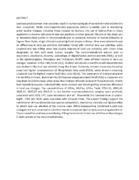| dc.description.abstract | Land use practices near river ecotones result in numerous inputs of terrestrial materials into the
river ecosystem. While macroinvertebrates population metrics is widely used in monitoring
water quality changes, including those induced by humans, the use of lipid profiles in these
organisms to monitor influence of land use practices is rather ignored. The aim of this study was
to determine lipid profile in macroinvertebrates as potential indicator of human influence in
Sagana River Basin, a high altitude tropical highland stream in Kenya. Sites were selected based
on differences in land use activities delineated: forest with minimal land use activities, while
cropland and saw milling areas had varying degrees of land use activities, with urban areas
designated as sites with most human impacts. The macroinvertebrate metrics such as
occurrence, abundance, diversity, percentage of oligo chaetes and chironomids (%OC), as well
as the Ephemeroptera, Plecoptera and Trichoptera (%EPT) index differed relative to land use
changes. Variation in the Fatty Acids (FAs), alcohols and sterols in benthic mac roinvertebrates
was related to the land use activities along the stream. Evidently, streams traversing the urban
areas had higher concentrations of Phospholipid fatty acids (PLFA), while streams traversing
croplands had the highest neutral lipid fatty acids (NLFA). The dominance of monounsaturated
FAs (MUFAs) in forest, shortchain FAs (SCFAs) and polyunsaturated FAs (PUFAs) in croplands and
longchain FAs (LCFAs) near urban areas clear indicate different sources of these materials, mainly
from terrestrial sources. Individual fatty acids, alcohols and sterols profiles discerned difference
in land use changes. The concentrations of SCFAs, MUFAs, LCFAs, TeoH, 27Δ5.22, 28Δ5,24,
28Δ5,22, 29Δ5,22 and 29Δ5,22 in the benthic macroinvertebrates samples were positively
associated with OC%, EPT, total abundance and eH’. Meanwhile the concentration of phytol,
AqOH, 27Δ5 and SCOH were associated with Simpson index. The current findings support the
combination of macroinvertebrates species composition, abundance, diversity and lipids profiles
to detect land use activities at the riverine scale. While implementing catchment-based river
management and conservation activities should incorporate lipid analysis as a management tool.
There is need for continuous monitoring of long term trends in land use activities on the changes
in lipid content of the macroinvertebrates | en_US |
